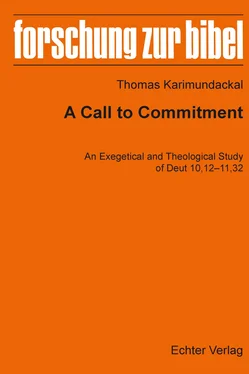24GEIGER, Gottesräume, 261.
25It is interesting to note that the participle נתן is used regularly with the ‘land-grant formula’ in Deuteronomy except in 12,1 and 28,52. LOHFINK, Samen, 271, relates the use of qal perfect נתן in 12,1 to God’s speech to Abraham in Gen 15,18. According to him the perfect נתן in 12,1 recognizes an allusion to Gen 15,18 because the gift of the land has already been accomplished.
26Cf. NIELSON, Deuteronomium, 143; MCCONVILLE, Deuteronomy, 213; ROSE, Mose 12-25, 9-26 and BRUEGGEMANN, Deuteronomy, 142-148. This is the last time that the instruction “to observe to do the statutes and the ordinances” appears in relation to the gift of land in Deuteronomy (cf. 4,1.5.14; 5,31; 6,1). BRAULIK, Deuteronomium 1-16,17, 90, identifies the land as the purpose of the instruction to observe to do the statutes and the ordinances, cf. also GEIGER, Gottesräume, 261. HOWEVER, DRIVER, Deuteronomy, 151 and MERILL, Deuteronomy, 229, consider that 13,1 introduces a new theme in ch. 13, i.e., the case of the false prophet. The role of 13,1b may further speculate the beginning of a new section in 13,1, for example BRAULIK, Deuteronomium I, 39, and LABUSCHAGNE, Speech, 122-123 identify it as a ״Kanonformel“. OTTO, Deuteronomium I, 539; REUTER, Dtn 13,1, 107-114 and RÜTERSWÖRDEN, Deuteronomium, 84, call it „Wortsicherungsformel“, while FINSTERBUSCH, Deuteronomium, 111, identifies it as „Autoritätssicherungsformel“.
27This demarcation also agrees with the majority of biblical scholars who consider 11,32 as the end of the pareneses in chs. 6-11 and 12,1 as the beginning of the Law Code in Deuteronomy, cf. LOHFINK, Hauptgebot, 234; OTTO, Deuteronomium, 1019; BRAULIK, Deuteronomium, 91-92; NIELSON, Deuteronomium, 128-130; FINSTERBUSCH, Deuteronomium, 95-97; MCCONVILLE, Deuteronomy, 205-207; WEINFELD, Deuteronomy, 453; BRUEGGEMANN, Deuteronomy, 142; NELSON, Deuteronomy, 141-142; WRIGHT, Deuteronomy, 158-159. CRAIGIE, Deuteronomy, 215.
28For the synonymous use of ארץ and אדמה, see PLÖGER, Deuteronomium, 121-29.
29BRAULIK, Gesetz, 149-150 does not see צדקה in Deuteronomy as an act but as an attitude and according to him it is measured vertically, not horizontally.
30Cf. BARKER, Grace, 79; MILLER, Deuteronomy, 121.
31Cf. BRAULIK, Siebengruppierungen, 38; idem, Rechtsfertigungslehre, 328. LOHFINK, Hauptgebot, 202, MILLER, Deuteronomy, 120, CHRISTENSEN, Deuteronomy 111, 183, and BARKER, Grace, 79, consider 4b as the central element of v1-6.
32For the allusion to the Shema of 6,4-5, cf. MERRILL, Deuteronomy, 189; MAYES, Deuteronomy 196; MILLAR, Living, 63, 66.
33BARKER, Grace, 81, states: “The statement כי עם־קשׁה־ערף אתה in v6b is not a description of Israel’s past, though subsequent verses give evidence from the past to support the contention. Rather, v6b stands emphatically at the end of the section as a definition of the present nature of the people”. For the similar treatment of Israel’s present nature of stiff-neckedness, cf. VON RAD, Deuteronomy, 74; GOLDINGAY, Diversity, 155; WATTS, Deuteronomy, 229; MILLER, Deuteronomy, 121; BRAULIK, Deuteronomium 1-11, 75.
34Unlike the parallel in Exodus, Deuteronomy emphasizes Israel’s sin of which the calf they have made is a symbol, cf. PECKHAM, Composition, 36; MERRILL, Deuteronomy, 191. For example in Exodus 32,19, Moses sees the calf and people dancing, while in Deuteronomy 9,16 he sees that the people have sinned (חטאתם). BARKER, Grace, 89, states: “that the issue of this section is broader than the golden calf and concerns the general sinfulness of Israel, which the golden calf typifies, is reflected in the addition of כל in v18”.
35The use of both verb and noun from √הטא in vl8 fuses vl6 and v21 and thus summarizes the sinfulness of Israel. The addition of כל in v18 also suggests that Moses is talking about their sins in general, or their continual sinfulness which the golden calf symbolizes. Moreover, in 9,18 Moses describes Israel’s sinfulness as doing what is evil in the sight of the Lord and provoking him (לעשׁות הרע בעיני יהוה להכעיסו). Both verb and noun from חטא occur together only here in Deuteronomy, cf. PECKHAM, Composition, 32-33; WEINFELD, Deuteronomic School , 339-340.
36Stiff-neckedness suggests Israel’s unwillingness to submit to the will of Yhwh, cf. BARKER, Grace, 82; MERRILL, Deuteronomy , 190. On the occurrences of קשׁה־ערף in the Old Testament, see KALLAND, Deuteronomy, 79.
37Unlike Exod 32,11-13 (cf. Num 14,13-19) there is no repentance here, but it is a pure intercession of Moses, cf. BRAULIK, Deuteronomium I, 80-81; GREENBERG, Prayer, 25. BARKER, Grace, 95, states: “This lack of repentance and forgiveness in Deuteronomy is the recognition that Yahweh’s standards are too high …”. MILLAR, Deuteronomy, 238, holds: “It is not forgiveness which dominates, but Yahweh’s faithfulness”.
38Cf. MILLER, Prayer, 270. BARKER, Grace, 86, argues that “Israel’s sinfulness is seen in the delay of the content of Moses’ prayer until vv25-29”.
39Cf. PECKHAM, Composition, 44.
40Cf. CAIRNS, Deuteronomy, 106. MILLER, Prayer, 93-94 and SCHNEIDER, Moses, 116, consider that Yhwh’s faithfulness to the promise to the patriarchs is the fundamental reason for his forgiveness. The importance of the promises to the patriarchs in Moses’ prayer can also be seen by the word play on personal pronouns in the narrative. In 9,12 Yhwh disowns Israel and makes Moses responsible for their failure (כי שׁהת עמך אשׁר הוצאת ממצרים v12). However, Moses in v26 and v29 refutes this by arguing that the people belong to Yhwh (עמך [v26.29] - the exact reverse of v12), and calls them as נהלתך (v26.29). He attributes their redemption from Egypt to Yhwh and not to himself (אשׁר פדית בגדלך אשׁר־הוצאת ממצרים ביד הזקה v26; אשׁר הוצאת בכהך הגדל ובזרעך הנטויה v29). Note also that v26 repeats the verb שׁהת (piel in v12; hiphil in v26; cf.10,10). In v27 Abraham, Isaac and Jacob are also addressed as ‘your servants’ (עבדיך v27). In v28, Moses identifies himself with the people (אשׁר הוצאתנו v28), which is again a refutation of Yhwh’s disowning of Israel in v12. See also BARKER, Grace, 97; GREENBERG, Prayer, 31.
41BOORER, Land, 295.
42CHRISTENSEN, Deuteronomy, 196 and MERRILL, Deuteronomy, 198, argue that the very instructions to prepare two more stone tablets at the beginning of the chapter indicate that Moses’ intercession is answered.
43Cf. WEINFELD, Deuteronomy, 418; PECKHAM, Composition, 49-51; THOMPSON, Deuteronomy, 144; MERRILL, Deuteronomy, 198.
44Cf. KLINE, Treaty, 75; DRIVER, Deuteronomy, 117.
45Most scholars consider v6-7 as a priestly parenthesis, resuming the travel narrative of chapters 1-3, cf. CRAIGIE, Deuteronomy, 200; THOMPSON, Deuteronomy 145; DRIVER, Deuteronomy 119; KALLAND, Deuteronomy, 85; CHRISTENSEN, Deuteronomy , 196; WEINFELD, Deuteronomy, 419. However, BARKER, Grace, 100, says “the mention of travel in these verses also suggests a future for the people and, hence, answered prayer”. The order of Israel’s stops in the wilderness listed in v6-7 seem to contradict the sequence in Num 33,31-33. This apparent discrepancy disappears, when we consider Num 33,37. The list of stops in v6-7 includes the locations after they stayed at Kadesh, which is mentioned in Numbers 33,37.
Читать дальше












